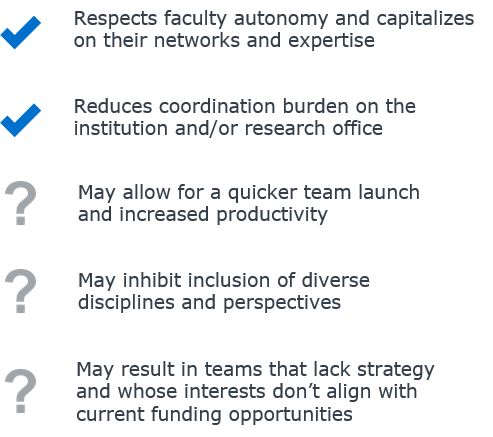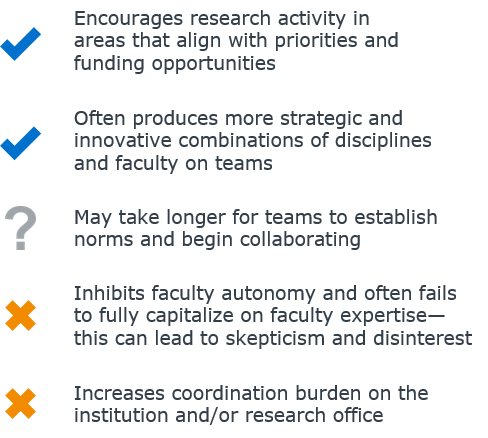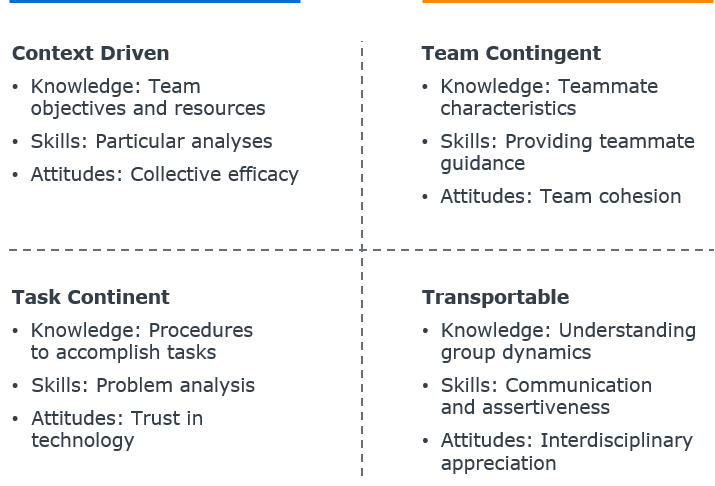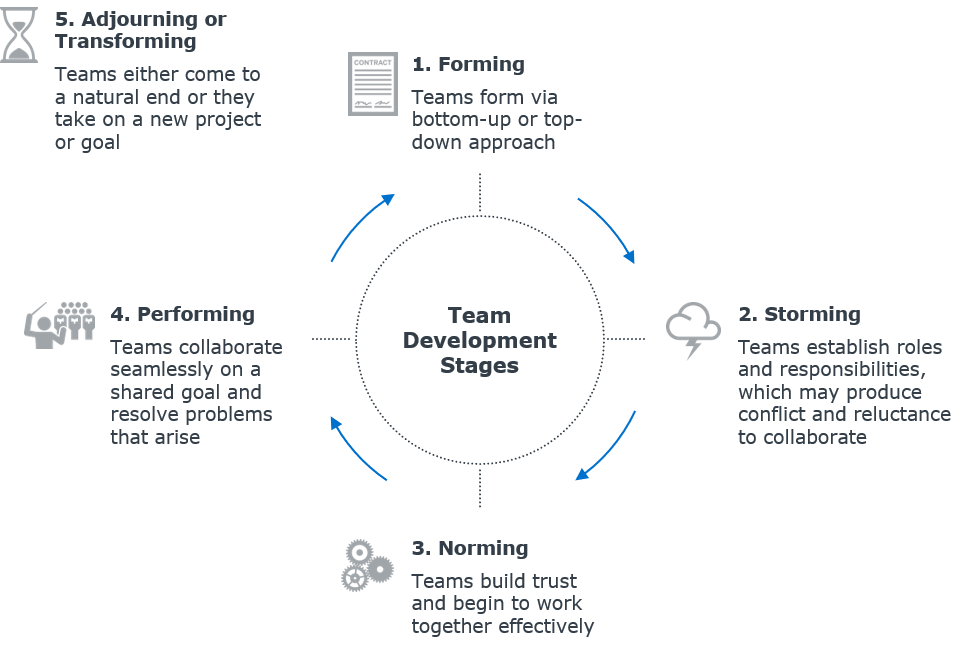Executive Summary
Although individual investigator research continues to receive funding and yield results, increased complexity and competition have pressured researchers to collaborate to generate solutions to large-scale, real-world problems. This led to the emergence of team science, which Cooke and Hilton (2015, 2) define as “research conducted by more than one individual in an interdependent fashion, including research conducted by small teams and larger groups.” Such collaboration has become the norm in almost all scientific fields and resulted in the creation of a new field of inquiry called the science of team science (SciTS), which seeks to understand cross-disciplinary research “by examining the processes by which teams organize, communicate and conduct research” (Falk-Krzesinski, Contractor, Fiore, Hall, Kane, Keyton, Klein, Spring, Stokols, and Trochim 2011, 146).
The SciTS literature emphasizes the potential benefits of team science—including innovation, novel findings, and high-impact research—but also highlights the barriers to faculty engagement and the challenges that research teams face. Faculty training and incentive structures are rarely aligned with team science, and large and diverse research teams often struggle to establish norms and expectations, communicate effectively, align goals, and integrate knowledge and findings.
20+

500+

While the body of scholarly research on team science offers few hard-and-fast solutions to the challenges associated with research collaboration, it does provide valuable frameworks that university leaders can use to contextualize team-based research on campus, diagnose current collaborative patterns and needs at the institution, and develop a strategy to encourage and support research teams.
This brief summarizes and organizes key findings from over 20 sources and 500 pages of scholarship and publications on research teams. It is designed to help chief research officers (CROs) and other university leaders quickly get up to speed on current thinking and approaches to team science and then leverage these findings to guide their team formation and support strategies. The brief provides an introduction to team science, including the benefits and challenges associated with research collaborations. It then organizes high-level insights from the SciTS literature in six categories of factors that can influence the effectiveness and productivity of collaborative research teams. Finally, it provides institutions with a self-assessment and prioritized reading list of secondary sources for CROs and other leaders who want additional detail.
Six Categories of Factors Contributing to Team Effectiveness and Productivity

Assembly

Composition

Leadership

Characteristics

Training

Progression
An Introduction to Team Science
Emergence of Team Science
Traditionally, science was conducted primarily by individual investigators working in their respective fields on disparate projects. But as scientific questions have become increasingly complex and competition for research funding has grown, researchers have had to collaborate with other investigators who possess complementary expertise and skills (Iglic, Doreian, Kronegger, and Ferligoj 2017). This “co-option” strategy allows would-be competitors to bolster their comparative advantage by collaborating on a team (Iglic et al. 2017). Along with increased competition for research dollars, both federal agencies and private sector organizations have begun shifting funding toward team-based research initiatives. These changes in the funding landscape have amplified the pressures on researchers to work in collaborative groups to solve large-scale, real-world problems such as climate change, food insecurity, and diseases. This led to the emergence of team science, which Cooke and Hilton (2015, 2) define as “research conducted by more than one individual in an interdependent fashion, including research conducted by small teams and larger groups.”
[Team science is] research conducted by more than one individual in an interdependent fashion, including research conducted by small teams and larger groups.
Cooke and Hilton 2015, p. 2
Today, collaboration is the norm in most scientific fields (Bozeman, Fay, and Slade 2013). In their latest book, Bozeman and Youtie (2018) even suggest that a “research collaboration revolution” is well under way. Over 90 percent of STEM research publications are now coauthored (Bozeman and Youtie 2018). When the authors surveyed over 600 academic researchers working at 108 very high-research universities across the United States, they found that more than one-third had never published a single-authored paper during their career and that it was extremely uncommon for single-authored publications to account for more than half of an author’s publication portfolio (Bozeman and Youtie 2018). And although collaboration was most common with coauthors at the same home university, 80 percent of all survey respondents had collaborated with at least one coauthor from another university (Bozeman and Youtie 2018).
As these trends have emerged, so has a new field called the science of team science (SciTS). The term was coined in 2006 when the National Institutes of Health (NIH) and the National Cancer Institute (NCI) hosted a joint conference. As a field of inquiry, SciTS seeks to “understand cross-disciplinary research by examining the processes by which teams organize, communicate and conduct research” (Falk-Krzesinski, Contractor, Fiore, Hall, Kane, Keyton, Klein, Spring, Stokols, and Trochim 2011, 146). Since this emerging field draws heavily on team research from other fields such as business and the military, there is wide variation in SciTS methodologies and activities (Baker 2015).
[The Science of Team Science seeks to] understand cross-disciplinary research by examining the processes by which teams organize, communicate and conduct research.
Falk-Krzesinski et al. 2010, p. 146
Value of Team Science
The SciTS literature emphasizes many potential benefits associated with increased collaboration. Anecdotally, team research is frequently linked with increased innovation as well as stability, verifiability, and access to resources and equipment (Disis and Slattery 2010; Iglic et al. 2017). Teams can theoretically also filter out poor ideas more efficiently, thereby reducing the likelihood of failure (Disis and Slattery 2010). Schaffer, Lei, and Paulino (2008) point out that team learning has the potential to increase the capacity of an organization to solve problems and therefore enhance the organization’s competitiveness. More concretely, studies have shown that team science produces novel research findings (Cooke and Hilton 2015). Wuchty, Jones, and Uzzi (2007) found that team-based publications have higher impact ratings and more patents than single-authored papers. Collaboration with domestic researchers has also been linked to increased citation rates (Katz and Hicks 1997).
Challenges of Team Science
Spark more collaboration on campus
Discover five proven ways to encourage collaboration in the workplace.
Read the InsightDespite the potential benefits, team-based research also poses new challenges. There are many barriers and disincentives to collaboration. Most faculty members are not accustomed to working on or leading teams, especially those that span departments, disciplines, colleges, and institutions. Furthermore, interdisciplinary research is rarely part of graduate-level programs, so most investigators lack formal training. On top of that, institutional reward and incentive structures are not aligned with collaborative, team-based research. While there is no definitive, quantitative evidence that collaboration has either a positive or negative effect on tenure, there is a persistent perception that it has a negative effect and many faculty struggle to demonstrate how they have made independent research contributions within the context of working on a team (Zucker 2012). There is also a lingering perception that individual grant-funded research with lead or senior author publications holds the most prestige. Concerns about credit can also deter some faculty from collaborating since authorship norms vary across disciplines. Many researchers are further deterred by the increased setup and coordination requirements associated with collaboration. Team-based research requires a heavy up-front investment but yields little immediate return in terms of publications.
Even if faculty members opt to form a research team, they frequently struggle to navigate and manage the diversity and large size of the group (Cooke and Hilton 2015). Team size and diversity also pose challenges for knowledge integration and goal alignment (Cooke and Hilton 2015). Geographic dispersion can further complicate team interactions and productivity, especially given the high task interdependence associated with collaborative research (Cooke and Hilton 2015). Furthermore, team research can reveal deep-rooted communication, status, terminology, and methodology debates and challenges (Cooke and Hilton 2015).
Spectrums of Collaboration and Integration
Given the challenges associated with collaboration, it is not surprising that coordinated teamwork remains relatively rare (Disis and Slattery 2010). Bennett, Gadlin, and Marchand (2018) present a continuum of scientific research collaboration that ranges from low to high levels of team interaction and integration. While more researchers are collaborating on research teams today, relatively few of those teams are truly integrated.
Types of Scientific Research Engagements
Low interaction and integration

Investigator-Initiated Research
- Investigator primarily works independently on a research project in and/or with his/her lab

Collaboration
- Each team ember brings expertise to address a research problem
- Group members work on separate parts of the problem and their work is later integrated
- Data sharing and brainstorming among team members varies, depending on the team
High interaction and integration

Integrated Research Team
- Each team member brings expertise to address a research problem
- Team meets regularly to discuss goals, objectives, and next steps
- Team shares leadership responsibilities, decisionmaking authority, data, and credit
- New leaders frequently emerge to take on project ideas sparked by collaboration
Adapted from Bennett, Gadlin, and Marchand 2018.
Collaborations also range along a spectrum of disciplinary representation and integration. The SciTS literature distinguishes between unidisciplinary, multidisciplinary, interdisciplinary, and transdisciplinary research (Fiore 2008; Baker 2015; Cooke and Hilton 2015). Despite this delineation, many authors continue to utilize these terms interchangeably, and relatively few institutions have customized their strategies to align with particular types of collaborative research.
Disciplinary Representation and Integration in Research Collaborations
| Collaboration Type | Definition |
| Unidisciplinary | Researchers from a single discipline work to address a common problem without any cross-disciplinary coordination or integraion |
| Multidisciplinary | Researchers from different disciplines each make separate contributions that are coordinated, complementary, and additive but not fully integrated |
| Interdisciplinary | Researchers from multiple disciplines integrate info, techniques, and data to advance understanding |
| Transdisciplinary | Researchers integrate and transcend disciplinary approaches to create wholly new frameworks, theories, models, and application |
The Science of Effective Teams
The following section highlights six categories of factors that the SciTS literature identifies as contributing to the effectiveness and/or productivity of research teams.
Six factors that contribute to the effectiveness of research teams
1. Assembly

Staffing is more complicated and challenging for teams because individuals cannot simply be selected based on their own knowledge, skills, and abilities—instead, it is the combination and compatibility of members that matter most (Cooke and Hilton 2015). As Bennett and Gadlin (2012, 12) explain, “A well put together team is one in which there is some synchronicity between the overall goals of the team and the aspirations and career needs of individual members.” As a result, team assembly is an emerging research strand within the broader SciTS landscape that examines how individual characteristics and team processes relate to effectiveness (Cooke and Hilton 2015).
One of the biggest questions about team assembly is whether teams should be “manufactured” or “organically formed.” Some studies have shown that self-organized teams tend to contain members who have previously worked together (Cooke and Hilton 2015). This can enhance team productivity, but it also tends to reduce team diversity. Melin (2000) found that collaboration works best when it is a voluntary process. However, funder stipulations about teams having a designated number of individuals from certain disciplines may inhibit self-organization (Cooke and Hilton 2015). Recent research, albeit not meta analyses, suggests that changing team membership can help improve team performance (Cooke and Hilton 2015). This challenges the long-held assumption that membership instability has a detrimental effect on team productivity (Cooke and Hilton 2015). Milojevic (2014) also distinguishes between core teams and extended teams. Over time, core teams accumulate new members proportional to their past productivity, although core members tend to remain the predominant authors on resulting publications (Milojevic 2014).
Comparison of Team Formation Processes
“Organic” Team Assembly
Faculty self-assemble to form a collaborative research team without input or direction from the research office and/or institutional leadership. These teams may or may not be formed in response to a specific funding opportunity.

“Manufactured” Team Assembly
Institutional leaders and/or the research office actively recruits handpicked faculty members to participate on a research team. These teams are often formed in response to a specific funding opportunity or an institutional priority area.

According to Iglic et al. (2017), individual characteristics and resources are two of the strongest predictors of faculty likeliness to collaborate (Iglic et al. 2017). Lungeanu, Huang, and Contractor (2014) found that the likelihood of collaboration on a proposal was higher for faculty with longer tenure, lower institutional tier, lower h-index, and higher levels of prior collaboration. Studies have produced mixed results in terms of the relationship between age and collaboration, although there is evidence that women are more likely to collaborate than men (Lungeanu, Huang, and Contractor 2014). One study also found that physical proximity increases the likelihood of collaboration (Claudel, Massaro, Santi, Murray, and Ratti 2017).
Although the SciTS literature does not provide any concrete recommendations for whom to include on a research team, it does point to some potential methods that institutions could use to make informed decisions about team assembly. For example, Cooke and Hilton (2015) suggest that task analytic and cognitive engineering methods could be applied to research team assembly. Research networking (RN) tools provide another avenue by which institutions could identify potential team members. Bennett, Gadlin, and Marchand (2018) also emphasize interviewing prospective collaborators during the team assembly phase to learn about their interest in and past experiences with working on a team. They also suggest asking about the prospective team members’ capacity to collaborate effectively when checking references (Bennett, Gadlin, and Marchand 2018).
2. Composition

Most studies on the relationship between team composition and team effectiveness have yielded conflicting or weak effects (Cooke and Hilton 2015). While it is generally accepted knowledge that having a balance of characteristics on a team will benefit the group, little research has actually confirmed this theory. Some studies have shown that a high diversity of disciplines represented on a team can improve scientific outcomes and increase research productivity (Cooke and Hilton 2015). Heterogeneous groups generally tend to outperform more homogenous groups, but heterogeneity can also complicate group processes and even impede productivity in some situations. For example, increased group size is linked to publication productivity, but this declines when the group is more heterogeneous (Cooke and Hilton 2015). The literature also has not generated a consistent answer on an ideal group size. A recent study suggests that larger research teams are critical for advancing science but smaller teams are more likely to be innovative (Wu, Wang, and Evans 2019).
Studies have shown there are positive relationships between demographics, national diversity, and the effectiveness of science teams (Cooke and Hilton 2015). Some also suggest extroverts may work more effectively on science teams than introverts and that having a balance of creative and conformist members can increase radical innovation (Cooke and Hilton 2015). Guimera et al. (2005) point out that the most effective research teams include a mix of relationships between newcomers and experienced incumbents. In fact, citation performance was positively associated with incumbents on the team, but only if the team was diverse (e.g., included both newcomers and repeated ties among incumbents) (Milojevic 2014; Cooke and Hilton 2015). Scholars have reported conflicting findings on the effects of team subgroups, although more recent studies are starting to reconcile these—balanced subgroups can improve performance if the subgroups are knowledge-based but can detract from performance if they’re based on demographic characteristics (Cooke and Hilton 2015).
Collaborator Attributes to Consider and Balance on Research Team
Diversity
- Discipline and/or campus unit
- Seniority (e.g., tenure status)
- Methodology
- Demographics (e.g., nationality, age, gender)
- Personality and disposition
Skills
- Communication
- Mentorship
- People management
- Leadership
- Award management
Experiences
- Prior collaborations
- Team experience
- Publication track record
- Funding track record
- Networks and connections
3. Leadership
Unsurprisingly, there is no one-size-fits-all leadership approach for team science. Instead, team leaders must often utilize several approaches, depending on the situational context (Cooke and Hilton 2015). Disis and Slattery (2010) advocate for transformational leadership, which describes leaders as motivators, moderators, and mentors who can connect disparate groups. In contrast, Steve Fiore (2008) points to shared leadership as a promising model for research teams. Most recently, Bozeman and Youtie (2018) presented a typology of five research management approaches but advocated for “Consultative Collaborative Management,” which is rare but highly effective. In this approach, all team members are consulted at key points in the collaboration to identify preferences and decide on specific actions. While this model doesn’t seem particularly innovative, Bozeman and Youtie (2018) argue that it’s rarely used because teams are simply on “managerial ‘autopilot.’”
Five Research Management Approaches
| Tyrannical | Directive | Pseudo Consultative | Assumptive | Consultative |
| • One person aggressively takes charge of the group and does not respect or solicit team members’ values and preferences • ~10-20% of all collaborations | • One person is in charge and makes critical decisions for the group but he or she is not malevolent • ~20-30% of all collaborations | • There is an appearance of consultation, but some team members’ perspectives and opinions are valued more than others’ • ~5-10% of all collaborations | • Some collaborators (often the most experienced or in authority) assume that others agree about collaboration preferences and values • ~50-60% of all collaborations | • All parties are consulted at key points during the collaboration to identify preferences and values and to make key decisions • ~5-10% of all collaborations |
| Result: Undermines collaboration | Result: Effectiveness (or lack thereof) depends on skills of the relevant leader and group | Result: Neither effective nor ineffective (but can be damaging if those in charge are manipulative) | Result: Effective when assumptions are accurate but otherwise generally ineffective | Result: Generally the most effective approach to collaboration management |
Adapted from Bozeman and Youtie 2018.
Regardless of approach, the SciTS literature suggests that persuasion and self-awareness are important attributes for all team leaders (Bennett, Gadlin, and Marchand 2018). Disis and Slattery (2010) also argue that everyone on a team must be willing to serve as both the teacher and the student in different situations.
Notably, the SciTS literature presents leadership and management as distinct albeit not necessarily mutually exclusive. According to Cooke and Hilton (2015), leadership involves setting direction, aligning people, and motivating and inspiring them. In contrast, management entails developing concrete plans for executing on tasks, allocating resources, creating an organizational structure and staffing plan, monitoring results, and solving problems (Cooke and Hilton 2015). In terms of leadership training, the literature suggests that it should emphasize how to guide team interactions, define team goals, and manage resources (Fiore 2008).
4. Characteristics

As Cooke and Hilton (2015) explain, the most effective teams promote intellectual disagreement and discussion while also containing conflict and developing trust among team members. Successful teams embrace differences of opinion from a scientific perspective rather than viewing criticism and disagreement as personal attacks. Furthermore, effective teams ensure the psychological safety of members. This means leaders and collaborators invite team participation, admit mistakes when necessary, acknowledge the shortcomings of their own knowledge, and are supportive and fair when holding colleagues accountable (Bennett, Gadlin, and Marchand 2018). Successful teams also set clear expectations from the get-go. Some opt to use collaborative agreements or research charters that formally articulate team goals and contributions, while others may use a “Welcome to My Team Letter” that explains what team members can expect of their leader and vice versa (Bennett, Gadlin, and Marchand 2018).
Regardless of the format, teams should discuss credit sharing before beginning their research and seek to identify potential sources of disagreement as early as possible. They should also ensure that collaborators understand the different roles and responsibilities of team members (Bennett, Gadlin, and Marchand 2018). This contributes to the development of a clear, shared vision, which is critical for subsequent team success.
5. Training
According to Steve Fiore (2008), it is best practice to conduct several levels of analyses to assess team training needs. First, an organizational analysis can be used to pinpoint when and where training is needed, as well as the degree to which the institution supports training implementation (Fiore 2008). Second, task-level analysis allows leaders to identify the content that must be mastered in order for the team to be successful (Fiore 2008). And third, team-level analysis can illuminate which team members need training and whether individual or group training is most appropriate (Fiore 2008). Fiore (2008) also distinguishes between team-general competencies, (e.g., communication skills) and team-specific competencies (e.g., knowledge of team member roles and abilities), as well as task-generic competencies (e.g., exchanging information and planning) and task-specific competencies (e.g., understanding objectives, appropriate methods). Trainings should be designed based on such needs analyses and with these competencies in mind.
Types of Team Competencies

Adapted from Cooke and Hilton 2015 and Fiore and Bedwell 2011.
Schaffer, Lei, and Paulino (2008) propose a cross-disciplinary team learning framework (CDTL) that includes three major dimensions: identification, formation, and adaptation. Identification constitutes an individual’s readiness for teaming and consists of extensive self-assessment, information seeking, goal setting, and planning (Schaffer, Lei, and Paulino 2008). Formation occurs when team members come together and engage in a series of cooperative and collaborative processes such as bonding, trust building, and project management (Schaffer, Lei, and Paulino 2008). Adaptation is an integrating process whereby teams create new knowledge, develop understanding and think innovatively, and align individual goals with shared team goals (Schaffer, Lei, and Paulino 2008).

The SciTS literature references several specific types of training that could be applied to research teams. Crosstraining could help team members develop knowledge of the roles and capabilities of their teammates, as well as shared group goals (Cooke and Hilton 2015). This type of training typically includes positional clarification, observation and modeling, and/or rotations that allow team members to learn about the full spectrum of team duties (Cooke and Hilton 2015). Team reflexivity training could be adapted to help science teams reflect on their prior performance and pinpoint opportunities for future improvements (Cooke and Hilton 2015). Similarly, guided team self-correction is a research-based approach that helps teams reflect on their teamwork during past performance, identify errors, and develop solutions (Cooke and Hilton 2015). Team coordination training also has the potential to help groups prepare for the demands of teamwork through vignettes (Cooke and Hilton 2015). Team dimensional training, which was developed by the Navy, and crew resource management (CRM) training, which was developed from aviation team training, could also be applied to research teams (Cooke and Hilton 2015).
6. Progression
After teams are assembled and trained, they continue to develop over time. The SciTS literature references numerous development frameworks that could be applied to research teams. One of the most widely cited examples is Bruce Tuckman’s 1965 Model of Group Development (Bennett, Gadlin, and Marchand 2018). This model presents five stages through which teams progress: (1) forming, (2) storming, (3) norming, (4) performing, and (5) adjourning or transforming. It can be used to assess a research team’s development and maturity
Tuckman’s Model of Group Development

Adapted from Bennett, Gadlin, and Marchand 2018.
Institutional Self-Assessment
Self-Assessment Questions for Institutions
See below for sixteen guiding questions that CROs and other institutional leaders can use to assess the current state of research collaboration on their campuses and prioritize team science investments accordingly.
1. How frequently are faculty collaborating on research? Does it vary by college, department, and/or discipline?
2. What types of research collaboration are most common? How integrated are faculty research teams?
3. What are the institutional “team science” goals? What level of collaboration is necessary to achieve those goals?
4. Are there particular disciplines and/or priority areas where increased collaboration would be beneficial for the institution?
5. Are faculty aware of the benefits of research collaborations? Are deans supportive of the concept?
6. What are the biggest barriers to faculty engaging in team science? Who and/or what would it take to address these?
7. Are there enough faculty to serve as viable team leaders? What training would they want or need?
8. Who on campus should be involved in forming and supporting collaborative research teams?
9. What services and structures are already in place to support collaborative research teams? Who provides them?
10. How much capacity does the research office have to enhance team support? What about other campus units?
11. Are most research teams on campus formed “bottom up” or “top down”? Which approach is more palatable and/or productive?
12. How can the research office and other campus units facilitate organic team assembly?
13. How long do most research collaborations last? How long do we want faculty teams to stay together?
14. When and why do collaborative research teams fail?
15. What do teams most frequently request and/or need (e.g., seed funding, project management support, communication training)?
16. Where should we prioritize investments and support services?
This resource requires EAB partnership access to view.
Access the research report
Learn how you can get access to this resource as well as hands-on support from our experts through Strategic Advisory Services.
Learn More